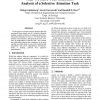Free Online Productivity Tools
i2Speak
i2Symbol
i2OCR
iTex2Img
iWeb2Print
iWeb2Shot
i2Type
iPdf2Split
iPdf2Merge
i2Bopomofo
i2Arabic
i2Style
i2Image
i2PDF
iLatex2Rtf
Sci2ools
CORR
2006
Springer
2006
Springer
May We Have Your Attention: Analysis of a Selective Attention Task
In this paper we present a deeper analysis than has previously been carried out of a selective attention problem, and the evolution of continuous-time recurrent neural networks to solve it. We show that the task has a rich structure, and agents must solve a variety of subproblems to perform well. We consider the relationship between the complexity of an agent and the ease with which it can evolve behavior that generalizes well across subproblems, and demonstrate a shaping protocol that improves generalization.
| Added | 11 Dec 2010 |
| Updated | 11 Dec 2010 |
| Type | Journal |
| Year | 2006 |
| Where | CORR |
| Authors | Eldan Goldenberg, Jacob R. Garcowski, Randall D. Beer |
Comments (0)

